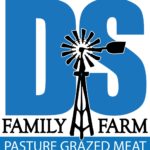Worried about what you are "really" eating? Have peace of mind with pasture grazed meats.
Grazing Stockpiled Grass
In earlier posts we have mentioned cattle grazing stockpiled grass. To explain, “stockpiled” grass is portions of pasture lands that were left un-grazed during the growing season for the specific purpose of grazing those areas during the non-growing season. We are now well into the non-growing season, no new grass growing around here this time of the year. During the growing season, we have more grass growing than what the herd can consume. This is a good thing, because we need that extra grass this time of the year when nothing is growing. It is a balancing act. If we had enough cattle to graze all the grass grown during the growing season, we would not have any stockpiled grass to graze during the non-growing season. The proper way to decide the number of cattle to run on a pasture in our part of the world is to determine how many cows you can graze during the non-growing season. That is, if you don’t want to feed hay.
In another earlier post we explained that we do make hay and we do feed some hay. The hay continues to act as insurance for when a natural event prevents our cattle from being able to graze (very deep snow & ice, fire, hail etc.). The main purpose of hay in our operation is to feed a small amount of quality hay as a diet supplement. Just a little quality hay (2 pounds per day) can keep a cows digestive system functioning properly while she consumes large amounts of low quality stockpiled grass (20+ pounds per day). It is a lot less work to let the cows harvest the stockpiled grass than to cut it for hay and feed it back to cows. In addition, cows rather graze than eat hay.



The tall brown grass that is taller than the back of our cows in the photos above is native grasses such as big bluestem and indian grass. Some of our pasture will have this tallgrass through next spring. It provides excellent cover for wildlife and will catch any blowing snow we get this winter. If the tall grass is still standing next growing season it will shade out new grass trying to grow. Our goal over the non-growing season is to graze and stomp the tall stuff down. Cattle are not able to digest the hardest tall stems and we don’t want to force them to eat it. By keeping their paddocks small, they are able to graze the good to medium quality stockpiled grass and stomp the bad stuff to the ground. Once the tough stuff is on the ground, our soil livestock (microbes, worms etc) will grind up the carbon into new soil organic matter. New soil organic matter will help grow more and hopefully better grass next year. It is a wonderful cycle to watch but hard to see at a glance.


With this type of year around grazing the overall quality of our pasture grass is improving. The next step is to build a herd of cattle that is adapted to our climate and pasture. At some point in the future we may be able to eliminate feeding hay as a diet supplement (our long-term goal).




